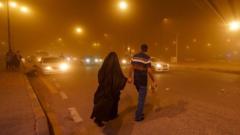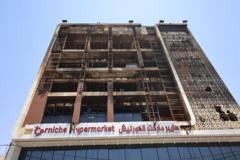More than 1,000 residents in central and southern Iraq have reported respiratory complications following a massive sandstorm that engulfed the region, as health officials rush to respond to the crisis.
Iraq Faces Health Crisis as Sandstorm Causes Respiratory Issues

Iraq Faces Health Crisis as Sandstorm Causes Respiratory Issues
Severe sandstorm blankets Iraq, leaving over a thousand individuals struggling to breathe. Health authorities are on high alert.
The recent sandstorm, characterized by a thick orange haze and plummeting visibility, has led to a surge in respiratory issues throughout Iraq. Health officials from the Muthanna province reported around 700 cases of suffocation, while overall, hospitals were swamped with over 1,000 patients requiring treatment for breathing difficulties.
The impact of the storm was felt across several provinces, with Najaf seeing more than 250 patients admitted, and a staggering 322 cases recorded in Diwaniyah. Moreover, Dhi Qar and Basra provinces reported another 530 individuals suffering from breathing complications. Amidst the chaos, pedestrians and police donned face masks to mitigate exposure, while paramedics provided immediate assistance to those in distress.
The dust storm, which has become increasingly common but reportedly intensified due to climate change, caused power outages and led to the closure of airports in Najaf and Basra. Experts warn that Iraq is becoming more vulnerable to such extreme weather events, categorizing it among the nations at highest risk from climate change, marked by excessive heat, recurrent sandstorms, and water shortages.
Iraq's environmental authorities have cautioned that the frequency of "dust days" will likely continue to rise in the coming years. In fact, a severe dust storm in 2022 resulted in one fatality and over 5,000 individuals seeking medical attention for respiratory ailments. As conditions are projected to improve by Tuesday morning, the long-term ramifications of such storms remain a pressing concern for both public health and environmental sustainability in Iraq.
The impact of the storm was felt across several provinces, with Najaf seeing more than 250 patients admitted, and a staggering 322 cases recorded in Diwaniyah. Moreover, Dhi Qar and Basra provinces reported another 530 individuals suffering from breathing complications. Amidst the chaos, pedestrians and police donned face masks to mitigate exposure, while paramedics provided immediate assistance to those in distress.
The dust storm, which has become increasingly common but reportedly intensified due to climate change, caused power outages and led to the closure of airports in Najaf and Basra. Experts warn that Iraq is becoming more vulnerable to such extreme weather events, categorizing it among the nations at highest risk from climate change, marked by excessive heat, recurrent sandstorms, and water shortages.
Iraq's environmental authorities have cautioned that the frequency of "dust days" will likely continue to rise in the coming years. In fact, a severe dust storm in 2022 resulted in one fatality and over 5,000 individuals seeking medical attention for respiratory ailments. As conditions are projected to improve by Tuesday morning, the long-term ramifications of such storms remain a pressing concern for both public health and environmental sustainability in Iraq.




















